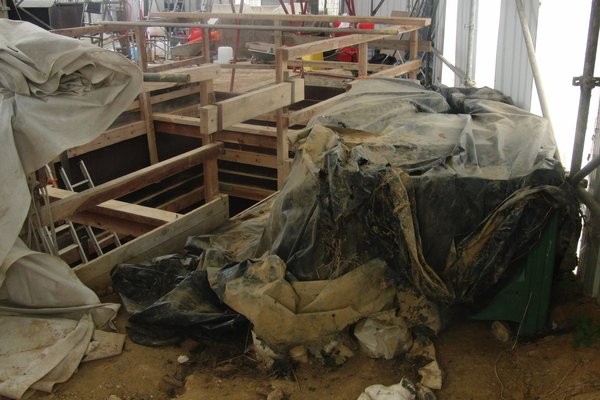Belgium
Neolithic Flint Mines at Spiennes
The Neolithic Flint Mines at Spiennes (Mons) comprise a vast underground series of galleries dug into two chalk plateaux.
They testify to the technological capabilities and culture of Neolithic populations. Shafts up to 16m deep were dug to get to the flint, which was used to make tools such as axes. No horizontal network joined the shafts; instead up to 5,000 shafts existed parallel to each other in some spots. The mine network stayed in use for centuries
Community Perspective: this is a WH Community Cult Classic, mostly due to the gradual opening up of the site to tourists, which can be learned from reading the reviews from the oldest to the most recent. Since 2015 there has been a modern visitor center and one can enter one of the shafts by pre-booked guided tour.
Site Info
Official Information
- Full Name
- Neolithic Flint Mines at Spiennes (Mons) (ID: 1006)
- Country
- Belgium
- Status
-
Inscribed 2000
Site history
History of Neolithic Flint Mines at Spiennes
- 2000: Inscribed
- Inscribed
- Type
- Cultural
- Criteria
- i
- iii
- iv
Links
- UNESCO
- whc.unesco.org
- Official
-
- silexs.mons.be — Website of the museum
- visitmons.co.uk — Visit Mons
All Links
UNESCO.org
- whc.unesco.org — whc.unesco.org/
Official Website
- silexs.mons.be — Website of the museum
- visitmons.co.uk — Visit Mons
News Article
- March 24, 2015 silexs.mons.be — New museum at Spiennes opens weekend of 4 and 5 april
- March 7, 2013 minesdespiennes.org — Flint mines closed until Q2 2014
- March 10, 2011 minesdespiennes.org — The Flint Mines at Spiennes will be closed until 2013
Community Information
- Community Category
- Secular structure: Mines
Travel Information
Reservation required
Not for Acrophobes
Recent Connections
-
Chalk
The Neolithic Flint Mines of Spiennes o…
-
Flint extraction
“In the Neolithic period, (from the las…
-
Perfect Inscriptions
2000
Connections of Neolithic Flint Mines at Spiennes
- Trivia
- History
-
-
Discovered during building of a Railway
"The digging of a railway line in 1867 cut through 25 mining shafts and is the origin of the discovery of the site." (Unesco) -
Neolithic age
"Criterion (iii): The arrival of the Neolithic cultures marked a major milestone in human cultural and technological development, which is vividly illustrated by the vast complex of ancient flint mines at Spiennes." (OUV)
-
- Ecology
-
-
Chalk
The Neolithic Flint Mines of Spiennes occupy two chalk plateaux (OUV statement)
-
- World Heritage Process
-
-
Perfect Inscriptions
2000
-
- Human Activity
-
-
Stone Quarries
Contain both open and pit quarries -
Flint extraction
“In the Neolithic period, (from the last third of the 5th millennium until the first half of the 3rd millennium), the site was the centre of intensive flint mining present underground.” (OUV statement)
-
- Constructions
-
-
Purpose Built Visitor Centre
under construction (opening 2015) -
Railways
"The digging of a railway line in 1867 cut through 25 mining shafts and is the origin of the discovery of the site".(UNESCO). The line ran from Mons to Chimay and is now closed but its line runs across the site)
-
- WHS on Other Lists
-
-
European Capital of Culture
Mons (2015)
-
- Timeline
- WHS Hotspots
- Science and Technology
-
-
Mines which can be visited underground
Flint. (Vertical ladder)
-
- Visiting conditions
-
-
Reservation required
The flint mine descent has to be booked in advance (a few days ahead seems fine, but check for availability), via phone / e-mail / online form at visitmons.co.uk. The museum can be visited without reservation. -
Strict no-photography policy inside
Officially no underground photos are allowed, but it is not strictly adhered to. -
Not for Acrophobes
"it is necessary to descend a vertical ladder through a trap door whilst wearing a helmet and a safety harness in order to go down"
-
News
- silexs.mons.be 03/24/2015
- New museum at Spiennes opens weeke…
- minesdespiennes.org 03/07/2013
- Flint mines closed until Q2 2014
- minesdespiennes.org 03/10/2011
- The Flint Mines at Spiennes will b…
Recent Visitors
Visitors of Neolithic Flint Mines at Spiennes
- Adrian
- Adrian Turtschi
- Afshin Iranpour
- Alexander Barabanov
- Alexander Lehmann
- alicemears
- A. Mehmet Haksever
- Ammon Watkins
- Argo
- Ask Gudmundsen
- Astraftis
- Atila Ege
- basementonline
- BaziFettehenne
- Bin
- Bram de Bruin
- Brendan Carroll
- Caspar
- Cheryl
- Christer Sundberg
- Christoph
- Christravelblog
- Clyde
- Colossus
- Cristina Erba
- Damientournay
- dana144
- Daniel Chazad
- David Berlanda
- DavidS
- Dimitar Krastev
- Dirk-pieter
- Dwight Zehuan Xiao
- Echwel
- Elaine McArdle
- Els Slots
- emvcaest
- Errol Neo
- Eva Kisgyorgy
- fabi-ddorf
- Farinelli
- Femke Roos
- Frederik Dawson
- Geert Luiken
- George Gdanski
- GeorgeIng61
- Hadrianus
- Harry Mitsidis
- henrik_hannfors
- heywhatever2
- Hubert
- Iain Jackson
- Ian Cade
- Ingrid
- Ivan Rucek
- Jakob F.
- Jana and Matt
- Janina Lehmann
- janis
- Jan Zimmermann
- Jarek Pokrzywnicki
- Jasam
- Jay T
- Jean Lecaillon
- Jeanne OGrady
- Jeffrey Chai
- Jezza
- Joel on the Road
- John Smaranda
- Jonas Kremer
- jonathanfr
- Joyce van Soest
- KarenBMoore
- Kbecq
- Knut
- krtek
- Kurt Lauer
- Lara Adler
- Lisu Marian
- Loic Pedras
- Luboang
- Lucas Del Puppo
- Luis Filipe Gaspar
- Maciej Gil
- Manon R
- marcel staron
- marc Rouserez
- Marlies van Wolfswinkel
- Martina Rúčková
- MaxHeAnouBen
- MH
- M. Huineman
- Mihai Dascalu
- Mikko
- Mikko Syrjä
- Mohboh
- nan
- Nihal Ege
- Olli-Pekka Turunen
- PabloNorte
- Patrik
- Paul Schofield
- PeterH
- Peter Lööv
- Philipp Leu
- Philipp Peterer
- Pieter Dijkshoorn
- Rafał Kałczuga
- Ralf Regele
- Randi Thomsen
- Roger Ourset
- Roman Bruehwiler
- Rudegirl
- Sabrina Liebehentschel
- Samy G
- Schnitzel
- Sergio Arjona
- Shandos Cleaver
- Solivagant
- Stanislaw Warwas
- stephanvermeulen
- Stijn
- Svein Elias
- Szucs Tamas
- Taotao Chen
- Tarquinio_Superbo
- Thomas Buechler
- Thomas Harold Watson
- Thomas van der Walt
- tommasorossotti
- tony0001
- Tsunami
- usagi1974
- Vanessa Buechler
- Walter
- Wojciech Fedoruk
- Xiquinho Silva
- YaroMir
- Yevhen Ivanovych
- Zoë Sheng
Community Reviews
Show full reviews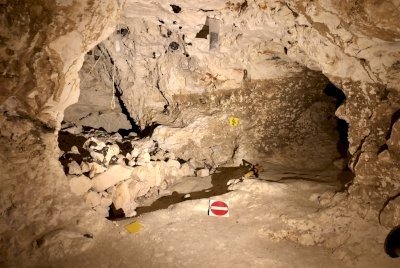
Visited September 2023
Knowing that visiting the mine itself – a reservation should be made a good while before the visit, I called the number found on silex.mons 6 weeks before the planned journey to Mons, made a reservation and paid for the underground tour. I arrived to Mons by train from Tournai the day before the visit to the mine, I spent the night in Mons (and I was really, really surprised, because the city is much prettier than Tournai or Charleroi; plenty of B&B and hotels in the city, and a very ‘good looking’ and wonderfully located youth hostel just below the unesco-listed belfry; and many restaurant in the grand’ place, and weekend morning market with local products and second hand stuff). In the morning on the day of visit I went to tourist information office to rent a bike – they open at 9:30 and have only a dozen bicycles so it is better to be earlier to get a bike, especially on weekends. First I went to Grand Hornu (WHS 1344 The Major Mining Sites of Wallonia), but this is not the topic of this post… BTW: Mons is a very good base for 5 WH sites – on bicycle!)
Then I rode to SILEX museum in Spiennes and I have to admit that the area has a lot of cycle paths! The museum is not too easy to find if you go there from Hornu, but the distance of 15 km is doable …
Keep reading 0 commentsJakob F.
Neolithic Flint Mines at Spiennes by Jakob Frenzel
Neolithic Flint Mines at Spiennes (Inscribed)
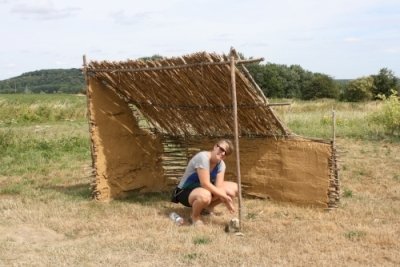
July 2018 - a quick stop in Spiennes to visit SILEX. Hmm, there are a lot of signs, so we parked the car, followed the signs, walked on green meadows and finally reached an, of course closed, entrance to the mine. However, we got the essence of this site, since flintstones were laying around everywhere and we understood, that there is not that much more to see. I am not a big fan of these kind of sites, but wanted to tick off. The weather was perfect, so it was a nice stopover, You could also see the belfries of Mons from the SILEX site.
Keep reading 0 comments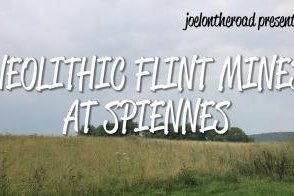
My wife and I visited Spiennes in August 2017. Contrary to the experience of other reviewers, we showed up randomly and managed to grab a free spot on the tour! It had just started so I missed the first few minutes, but it was in French and my grasp on that language is tenuous at best, so I didn't really miss anything. The guide was kind enough to give me the gist of what she was saying too.
The mines were surprisingly large underground, and I really enjoyed seeing the pits. Also very startled to find that in the hundred or so acres of the site, there are thousands of mines but only a handful have actually been excavated! Makes you really wonder what else is yet to be discovered.
See below for my full video review!
Keep reading 0 comments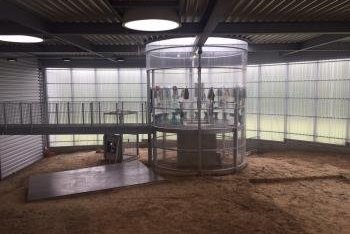
Finally ticked off the last Belgian site!
Was lucky to book mine visit on 26 August 2017. The price was 14 Euro. There was French speaking group and the guide first provided information for them and then English summary for me.
Only 6 people decided to descend and we all went through hook hanging procedure. The mine is quite atmospheric, with several layers of flint stone. The guide showed "scratch" gallery, the only place, where there are visible traces of mining instruments. The other were destroyed by excessive visitors during previous less controlled period. The miners used debris and waste to use it as elevated floor level for mining upper flint layers. Polished flint instruments were probably used as trade objects as they were found in the radious of 150 km (but there is hypothesis that polishing of flint stones took place not in Spiennes but in other area).
In overall interesting site and quite unique aspect of human activity is highlighted here. The difficulty of getting here also adds some charm. I liked the visit and some local dogs on the way from parking to the site.
Keep reading 0 comments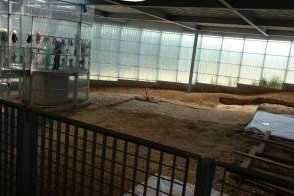
Thanks to Ryanair offering 30€ flights from Hamburg to Brussels I decided to finish Belgium by ticking off Spiennes. I contacted the museum and reserved a place for a Sunday afternoon visit. The visit includes the museum, an excavation site and a descent into one cave that covers several mines.
Flintstone was the key material in prehistoric times. The mines at Spiennes show to what lengths mankind would go to mine it. They would dig 10-20m deep holes with little to no light and only very primitive tools to use. It’s interesting to think about this as an early industrial site.
Similar mines are found all over Europe. The Polish tentative list even features one of them, Krzemionki. I am hard pressed to see why Spiennes would be special compared to the other mines. But seeing I am always arguing against serial nominations, I think having a flint stone mine on the list is fine. Even if the criteria was only that Belgium proposed this type of site first.
Getting There and In
Public transport options to Spiennes on the weekend are non existing. On my way to the museum I walked from Mons Trieux bus station (>1h). Another option would have been to go to Saint Symphorien.
On my way back the very kind guide gave me a ride and dropped me off in Mons. Maybe you can arrange for her to pick you up, too, if you call the museum ahead of …
Keep reading 0 comments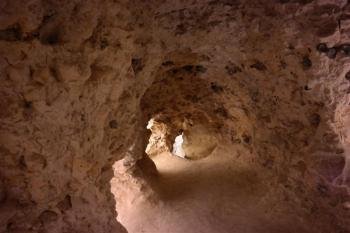
Without going into detail, we can confirm that arranging a reservation for a descent in the mine is a nice example of Belgian surrealism (cf. Solivagant's review). But after a few atempts we made it to Spiennes and we can also confirm that the local staff and guides are very helpful and knowledgeable.
It seems that the parking close to the site is meant for the elderly and/or disabled, but you can park at the Rue du Petit Spiennes - Rue de Nouvelles intersection which is only a 5 minute walk to the site.
The tour starts with an explanation above ground and ends with a descent in the mine. This last part takes some time since everyone has to get in/out of safety gear. In the mine, three layers of flint/silex are clearly visible.
In principle, taking pictures is not allowed but - as we have also experienced in a number of other Walloon WHS - the guides mentions that as far as they are concerned taking pictures is no problem (and that they only have to say it pro forma).
Ps: the first Sunday of the month, the entrance to the site is free of charge.
Keep reading 0 comments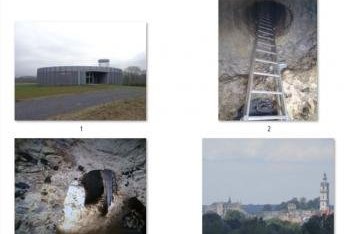
This is another fascinating WHS in Belgium, and I had to come back here after 4 months for the tour of the mine.
I have taken tours at many World Heritage mines, in Norway, Sweden, Germany, Poland, Slovakia, Hungary (Ferto), Japan, etc, but this one is the oldest by far, which is part of the fascination.
Photo 1: The Interpretation Center built over a flint mine.
Photo 2: Inside the mine.
Photo 3: Inside the mine.
photo 4: View of Mons from the Interpretation Center with the World Heritage Belfry.
Keep reading 0 comments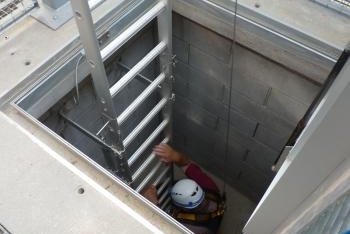
Back in 2001 we had visited Spiennes to find ….. nothing but a field! So, when we were “over on the Continent” (note our very British way of looking at the World!!) for the WH Site “get together” in Aug 2015, we were determined to get more out of a repeat visit. We knew that a lot had changed across the 14 years, particularly in the form of a new Visitor Centre named “SILEX’S” (= “Silex i.e “Flint” of Spiennes”) which had only opened in April 2015 and which, apparently, offered more chance to make a descent than was previously available.
So, I started trying to make arrangements in early July. At the same time I made a booking for the Rietveld Schroeder Haus – so easy with a simple Web booking system which operated with exemplary Dutch efficiency. But, oh how different for Spiennes!! At the risk of over-extending this review it might be of use to others who want to do a descent to recount our experience. The prime method for making a reservation is by telephone to Mons Tourist Office – not very “user friendly” for those living overseas! Trying to “improve” the system, I e-mailed the Tourist Office which passed me on to another e-mail address for the booking …. which, at first, answered my questions by simply cutting and pasting the information on the Web site which my e-mail made perfectly clear I had already seen! To cut a long story short it appeared that …
Keep reading 0 comments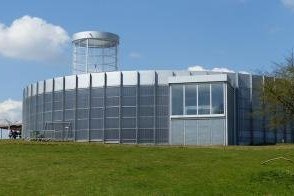
I finally visited this WHS in April 2015. I say finally because I had been wanting to visit and 'complete' Belgium's WHS since 2012 when the site was closed to build a visitor centre and make it more accessible. The site was planned to reopen as early as 2013 but a series of postponements meant that the new interpretation centre was only inaugurated on Easter Saturday, 4th April 2015. The easter weekend was advertised as Mons' celebration period as European Capital of Culture 2015 and Silex's interpretation centre was only 1 of 5 new museums inaugurated during that weekend with free entrance. Well, I seized the opportunity and visited Mons and Spiennes. By car, Silex's is best reached through Hyon as now there are several signposts indicating the way to the site and there's only a short 10 minute walk on a flat terrain making the site wheelchair accessible. Otherwise the site is reachable through Nouvelles where again there are a series of signposts indicating the way to a dead-end amidst the Belgian countryside and fields. Cars can be parked here and a 12 minute walk on a muddy terrain past a 1915 aqueduct and water management area and a fleet of stairs lead you to the new interpretation centre. I opted for the latter only because I had time to kill and enjoyed some birdwatching along the way. The Silex interpretation centre proper seems quite futuristic and out of place compared to its surroundings yet at least the WHS …
Keep reading 0 comments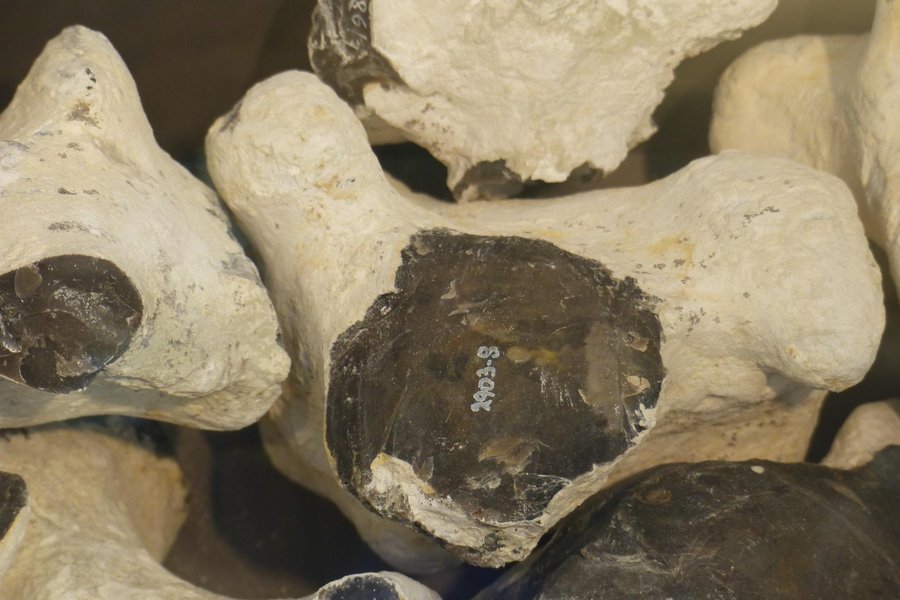
Very poorly signposted and when we eventually found it all that was there were remains of excavations in a cleared site, no-one about. Probably v important site, obviously hearts of knapped flints everywhere. One to tick off if you are collecting sites, we were passing nearby to see the canal lifts too, and Tournai (also disappointed due to rebuilding until 2016!) 9th July 2011
Keep reading 0 comments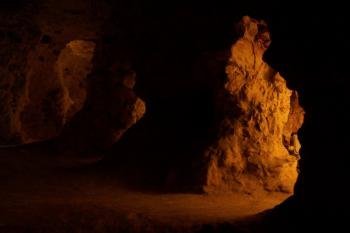
After hearing about how tricky it can be to gain access to this site, I figured it should be my aim to get to them as I visit Belgium pretty regularly. Now that the official website has all the relevant information and an exceptionally useful map, mixed with the end of my studies meant that a visit was possible. With the map it was pretty easy to find the site and there are a few small signs to point you there from the village of Spiennes.
We turned up just as a group was going down, so after a brief introduction we followed them down. The mine we visited was 8-10 metres deep and to gain access to it you have a nice climb down a ladder. The main part of the mine was tall enough to stand in and had several different shafts. There were numerous different chambers, and you could see how they were sculpted and where the flint came from, in places there were even marks left by the Neolithic men who dug the flint out.
Our particularly friendly guide was very knowledgeable and described everything we needed to know for a good understanding of these 6,000 year old mines. He also described how tourism in the mines worked. They are open 10 days a year and on average get about 150-200 visitors a year. It was a decision of a local politician in Mons to put the site forward as a WHS. An inspired choice it …
Keep reading 0 comments
I would like to say there is now a Web site about this wonderful place, with some explanations about Spiennes, flintsones, the mines, etc. and an access map, to avoid getting lost. Visits are possible every first sunday of teh month
http://www.MinesDeSpiennes.org
Keep reading 0 comments
Visited the site a few weeks ago. We found the on site archeologists very informative.Helene Collet afterword followed us to the museum to share more information. This area is a great experience for anyone interested in pre- history and flint technology.
Terry Keefer
Keep reading 0 comments
Neolithic Mines at Spiennes.
I have 'visited' this place twice, in 2001 and 2002.
As you say, it does not seem to exist, at least it is impossible to find. When you reach the village Spiennes, the site is clearly marked with signs 'Sites prehistoire de Spiennes', but when you have gone through the village, all traces disappear. There is no way to find out where to go. I went to the tourist office in Mons, and they had a brochure saying that the site is closed until further notice, because of the dangerous condition of the site.
But why do they insist on having the signs along the streets???
Of my 230 sites, this has been the most disappointing.
Keep reading 0 comments
I tried to visit the Flint Mines at Spiennes this 6th October 2002, but there was no possibility to visit, nor any indication whatsoever of Time when this was possible etc.
Needless to say I was very disappointed.....
The mines are probably very interesting but the visiting organisation is a disaster.....
Keep reading 0 comments
During a trip to Belgium in June 2004 and specifically to the Wallonian area I had decided to visit the Neolitic Mines of Spiennes as my 138th World Heritage Site. Having arrived in the city of Mons, I jumped into a taxi heading for the small village of Spiennes were I had made an appointment with archeologist Helen Collet who was going to show me the site. She was waiting for me and we drove off to the first of the two archeological sites while telling me that the whole area of Spiennes is scattered with over 1000 Neolithic mines, holes in the ground, around 4-12 meters deep, where the ancient Neolithic men dug for flint stone about 4000 years BC. “Tools made from Spiennes flint has been found as far as in eastern Germany”, Helen continued. “But unfortunately we have only been able to investigate two mines so far. But these two are very deep, something that is quite unusual from that period”.
The first of the two sites was housed inside a small building on top of the first “hole”, built by the archeologists who first discovered the mines in the late 19th century and now the office for the archeological investigations. After a coffee and some initial discussions about Neolithic mining with Helen and her husband Michel who now had joined the party, it was time to enter the underworld. My outfit of the day was completely discarded by Helen and Michel in favor of some more …
Keep reading 0 comments
This was a facinating experience! I am a "full-time" Flintknapper making my living by knapping flint. This site demonstrates the high prehistoric value of good quality knappable stone. The labor to extract this flint is staggering! Our visit was arranged by Pascal Chauvaux of Belgium. It was difficult to find, but find it we did!
Thanks for the incredible tour! Thanks Pascal!
Keep reading 0 comments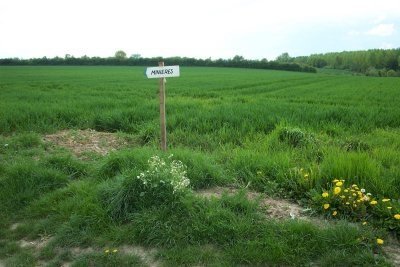
Over the last months, I enjoyed the 'discussion' below among the visitors about how to get to the mines in Spiennes (and even more important - how to get in). But gradually the basic visitor information became clear: there are guided tours on the first Sunday every month, and you have to be very alert in the town of Spiennes to spot the site. To make it even easier: via the link 'Mining site of Spiennes' above there's access to a map.
Besides an extra round on the Mons Ring road (there's only a small sign to Beaumont), I had no trouble finding it. In Spiennes the 'minieres' are even signposted. From above the ground, the site looks remarkable like any farming field. The archeological excavations are limited to two areas: one official site and one for volunteers.
One of the guides showed me around. First some open excavations on the surface. After that we descended a steep iron ladder, to get 10 meters below the ground. Here we arrived in a well-lit cave network (the electrical lights were only recently installed). The difference between the white chalk and the 2 flint layers was clearly visible. The guide explained the techniques used by the neolithic people to get to the flint. It was a tough and patient job carried out precisely. An amazing experience to stand here thousands of years later.
Keep reading 0 comments
